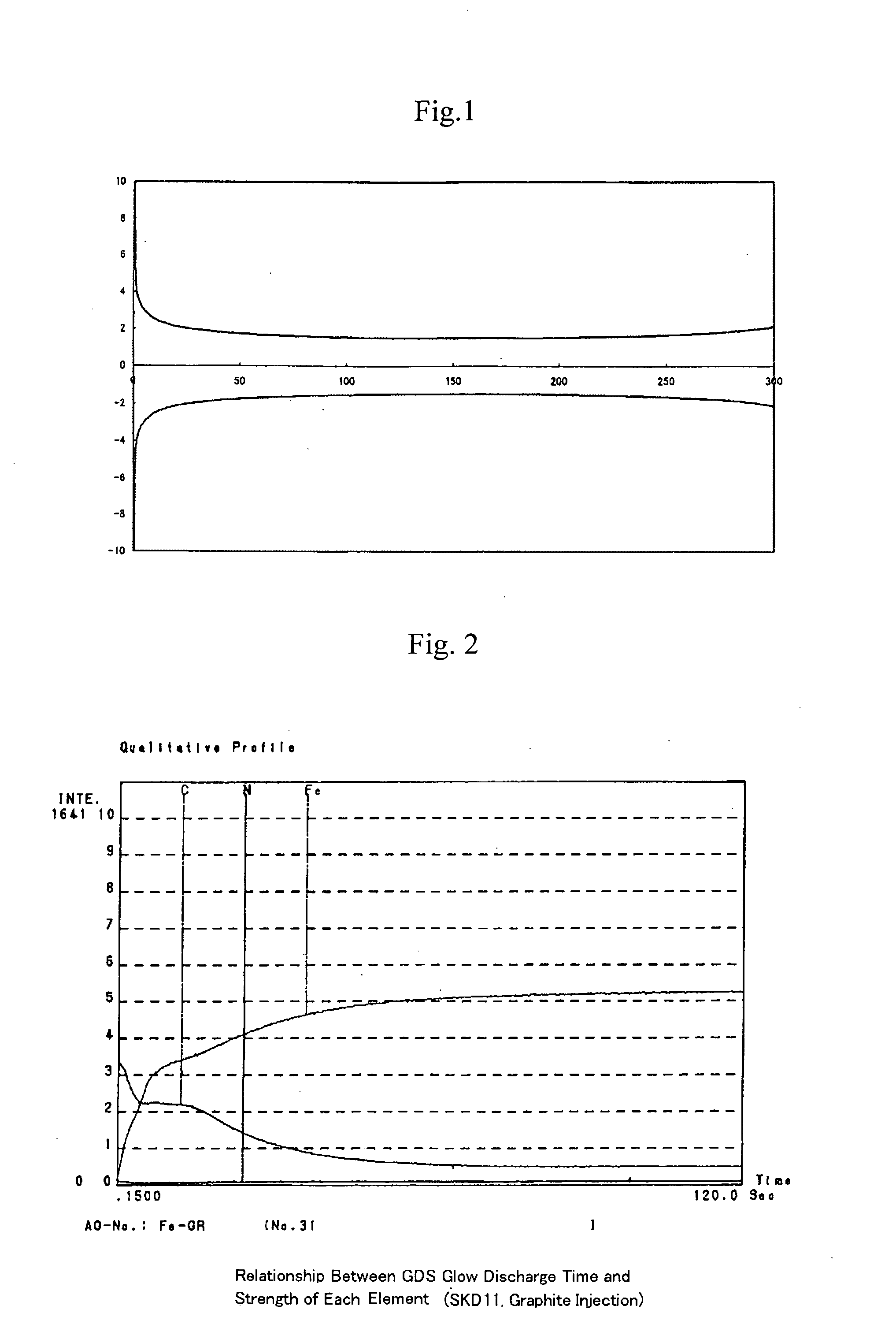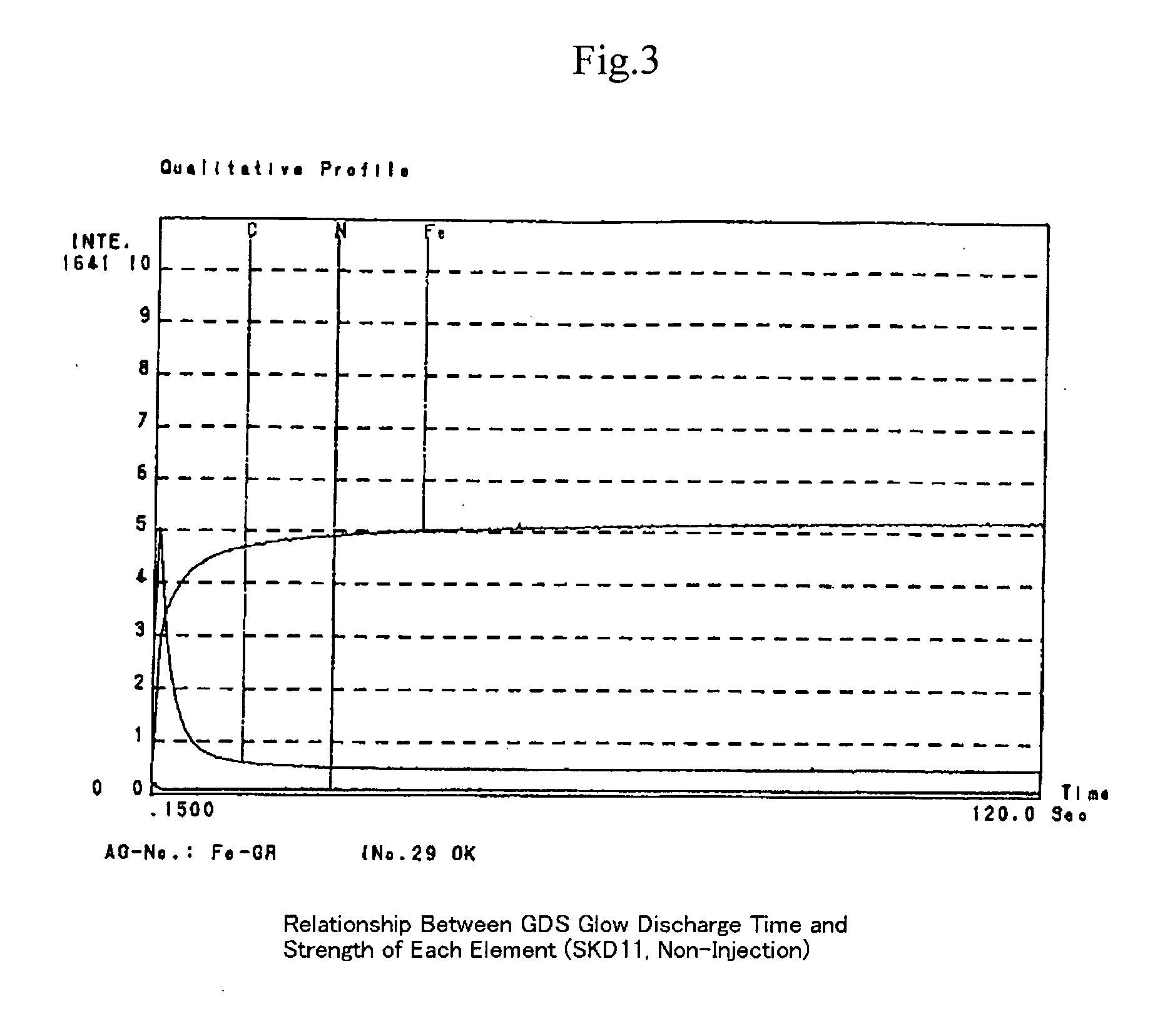Injection nozzle, blast processing device and blast processing method with the injection nozzle, method of forming lubricating layer by the blast processing method, and sliding product with the lubricating layer formed by the method
- Summary
- Abstract
- Description
- Claims
- Application Information
AI Technical Summary
Benefits of technology
Problems solved by technology
Method used
Image
Examples
Example
[0158] In the analysis result (FIG. 3) of the Comparative Example 2, the carbon components C are extremely reduced from the work piece top surface, and in the Embodiment 2 (FIG. 2), many carbon components are detected from the top surface to a certain depth, namely approximately 1.2 μm in the depth. Accordingly it is understood that in the Embodiment 2, a lubricant layer into which carbon components are properly penetrated is formed.
(2) SEM-EDX Analysis
[0159] By using a combination of a field emission scanning electronic microscope (FE-SEM) and an energy dispersive spectroscopic analysis (EDX), the surface analysis is performed repeatedly in the identical portion after the Ar ion sputtering treatment, to analyze distribution of the existing elements in the portion. As a work piece are used SKD11, SUJ2, and A7075.
[0160] S-4100 Vacc: 15 kV made by Hitachi Co., Ltd. is used as a field emission scanning electronic microscope (FE-SEM), and EDS2000 system made by IXRF SYSTEM as an ene...
Example
[0184]FIG. 14A shows a friction behavior view of the Comparative Example 3, FIGS. 14B and C show an optical microscopic photo of friction scars of the Comparative Example 3, and FIG. 14D shows a roughness curve of disc friction scars of the Comparative Example 3. The friction behavior fluctuated from the beginning of the friction and showed a friction coefficient of approximately 1.0. It was observed that from the state of the friction scars the ball was worn and the disc, as seen from the roughness curve, was swollen than the original surface due to transferring from the ball.
[0185] On the other hand, as seen from FIGS. 13A to 13D, the friction coefficient of the Embodiment 3 where the graphite was injected was maintained as the friction coefficient value of approximately 0.2 under the load of 4.9N to the friction frequency of approximately 3000 times.
[0186] When a sample was used in such a way that an injection distance of the graphite was 50 mm, other injection conditions were ...
Example
[0187] Next, with regard to the Embodiment 4 and the Comparative Example 4, a slip rate was set as 20 mm / sec and in the Comparative Example 4 a load was set as 0.49 N, and in the Embodiment 4 a load was set as 1.96 N. Under these conditions the friction experiment was performed.
[0188] In the Comparative Example 4, the friction coefficient showed equal to or more than 0.5 from the beginning of the friction and the friction fluctuation and the disc wear were large, and further, much adhesion on the ball from the disc existed. Accordingly the wear amount could not be measured (FIG. 16A to 16D).
[0189] In contrast, the Embodiment 4 maintains a friction coefficient value equal to or less than 0.2 until the number of frictions exceeds 2000 times under a load of 1.96 N and the roughness curve of the disc friction scars shows clearly that the roughness is smaller than that of the Comparative Example 4 (FIGS. 15A to 15D).
[0190] In addition, in the Embodiment 4, the wear amount of the ball ...
PUM
| Property | Measurement | Unit |
|---|---|---|
| Fraction | aaaaa | aaaaa |
| Pressure | aaaaa | aaaaa |
| Length | aaaaa | aaaaa |
Abstract
Description
Claims
Application Information
 Login to View More
Login to View More - R&D
- Intellectual Property
- Life Sciences
- Materials
- Tech Scout
- Unparalleled Data Quality
- Higher Quality Content
- 60% Fewer Hallucinations
Browse by: Latest US Patents, China's latest patents, Technical Efficacy Thesaurus, Application Domain, Technology Topic, Popular Technical Reports.
© 2025 PatSnap. All rights reserved.Legal|Privacy policy|Modern Slavery Act Transparency Statement|Sitemap|About US| Contact US: help@patsnap.com



